My Airbnb in Downtown Spartanburg, SC
I created an Airbnb rental in a Spartanburg, SC duplex. This is the story of my Airbnb.
In June of 2018 I moved to Spartanburg, South Carolina and started a new job. With money a little tight I looked at houses that would allow for a rental opportunity. I had become enamored with staying at airnbnbs during my business travel, so I had in the back of my mind the idea that I could create an airbnb rental unit.
Airbnb? What? What is that? I still get these questions from my mom years later.
Airbnb is a website that allows people to list their homes, extra rooms, apartments, whatever, for nightly rentals. This puts these places as competitors to hotels, rather than competitors to long-term apartment rentals. You get more per-night, but you have to deal with high turnover. Think bed and breakfast without the breakfast.
The system works because both rental units and renters get rated with every transactions. The dirty homes and the mean landlords get rated poorly. The renter who parties all night, burns the couch and parks on the front yard will quickly get blacklisted.
I've stayed at dozens of Airbnbs. Some where better than others, but none were bad. I will go further to say that all were better than a hotel room.
Back to my story. I considered buying a normal house and renting out extra rooms. Lots of people do this on Airbnb. I've stayed at these places. You pay about half as much as having a whole place to yourself, and you are likely to have social interaction with the owners.
If you are the owner, you have to have your act together. If you have no problem keeping your place clean, and can handle friendly exchanges with people who suddenly show up to live with you, this is a reasonable option. I stayed with a young couple who had an extra room in their apartment. They rented out that room often enough to pay their rent. Not a bad deal.
Perhaps I would have gone for this option. Or perhaps I would have just rented out a room on a long-term basis. All speculation. I was lucky enough to find a wonderful duplex in Spartanburg's nicest downtown neighborhood.
Back in the day, in this case the 1930's, neighborhoods were less isolated by class and income. Go to a new suburban development today and you will find the price of all houses within about 20% of each other. Maybe, if the development is large enough, they will have it divided into sub-neighborhoods where you have some cheaper houses in one section and ritzier homes in another, but basically all the houses are relatively close in price.
In Converse Heights, from the git-go, there were large houses, small houses, single-family homes, and duplexes. Converse Heights was built on a cotton plantation just East of downtown Spartanburg. Follow Main street past the Church district and you come to Converse College North of Main Street, and Converse Heights South of Main Street.
I was lucky enough that one of those old duplexes was on the market when I moved. It hadn't sold for a long time, it was taken off the market for a while, and then was put back on the market after I had been looking about a month. I found it after looking at dozens of homes in the greater Greenville-Spartanburg area. Just ask my overworked realtor, Robert R.R. Ortega, of Keller-Williams.
My job is in Greer, SC, midway between Greenville and Spartanburg. Greenville is the larger sister, but these two towns are often referred to as Greenville-Spartanburg. I wanted to be in an urban area. This desire favored Greenville, which is larger, but downtown Greenville is pricey these days, which meant I either had to look out into the suburbs or look in Spartanburg.
Urban is a relative term. Spartanburg is really just a large small town, while Greenville is more of a small, small city, but both have vibrant downtowns with lots of night life. There is a lot to do here and it gets livelier every day.
Having looked at a lot of places I can honestly say that Converse Heights is the nicest old neighborhood in Spartanburg. Some people disagree with me, but...they are wrong.
When I closed on the house in July of 18 the house was in desperate need of a paint job, and much of the need was driven by gutters that leaked and poured water on the wood shingles. Staying wet way too long they rotted.
The house was mostly in good repair, but needing paint in every room.
Being a duplex it had two kitchens. The one had recently been redone. The cabinets were basic, but new. The countertop was inexpensive formica, but new. The second kitchen had old cabinets. The countertop on this one had water damage. The sink was porcelain coated cast iron, and rusting at the drain. For rental units these might do, but for an airbnb they needed to be revamped.
The one half of the duplex was rented when I bought it so I moved in to the other, the smaller half, and commenced to making it presentable for airbnb.
Like most rentals the interiors were painted neutral colors. The walls were cream downstairs. The bedrooms upstairs were a light blue. Even if you liked these colors the walls were desperate for new paint.
On the plus side, the white trim was mostly in good shape.
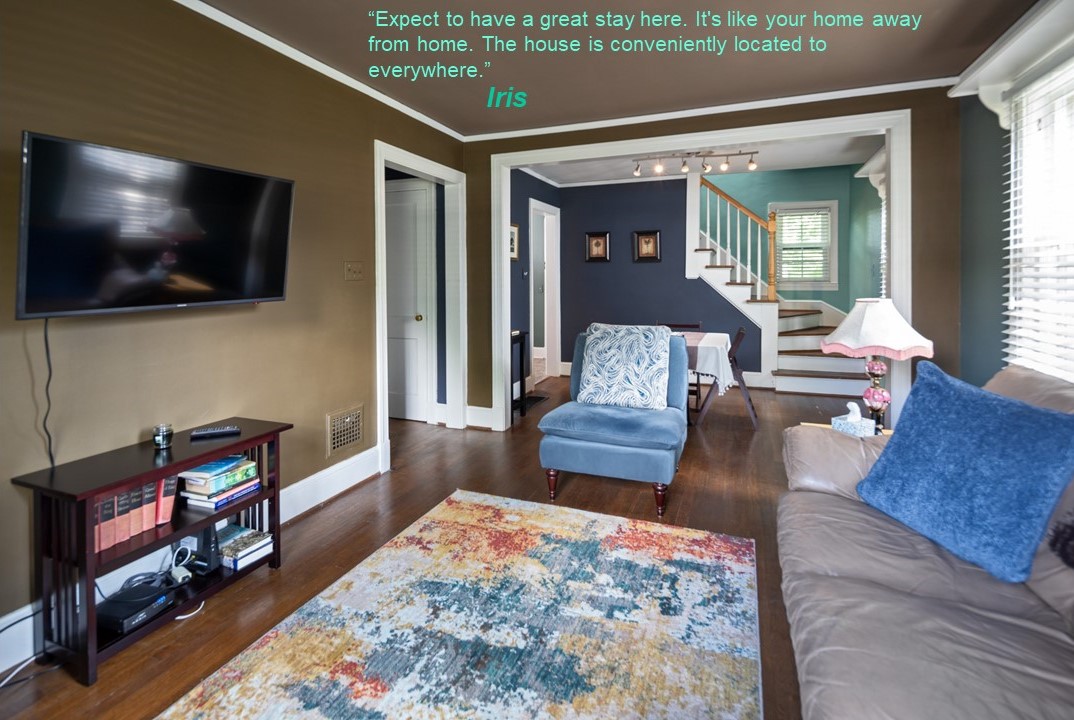 Three colors in my TV room and two in my dining room
Three colors in my TV room and two in my dining room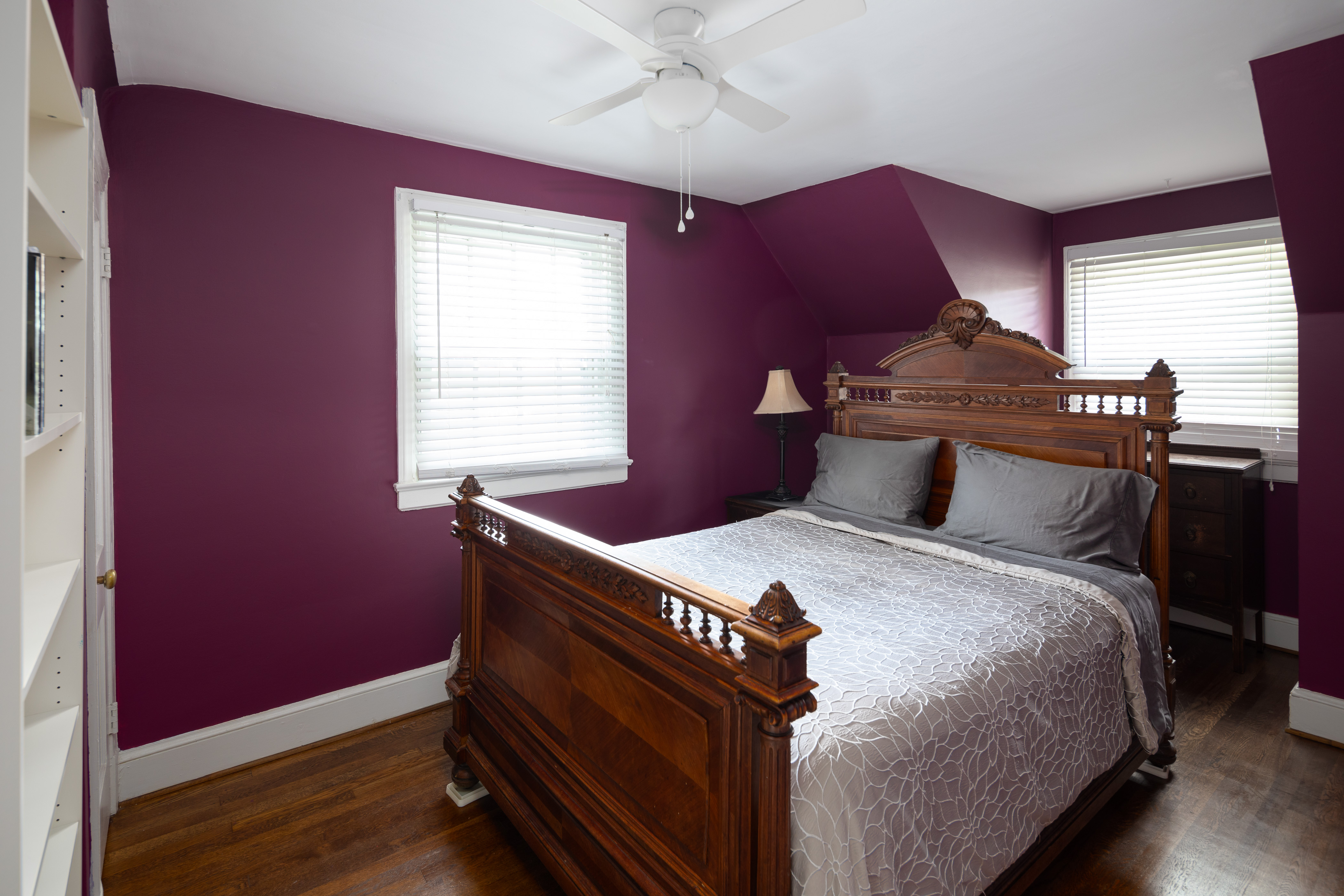 Fine Wine is the name of this paint. It looks like a garnet in sunlight, but takes on a purplish hue at night. The antique bed is way too big for the room, but for now it will do.
Fine Wine is the name of this paint. It looks like a garnet in sunlight, but takes on a purplish hue at night. The antique bed is way too big for the room, but for now it will do.I wanted to be bold with my room colors. I think you will agree I was bold. Perhaps too dark, but bold. The beautiful thing about paint is that you can always do it again if you don't like it. I did that twice in this house, where I picked out too garish a yellow and too bright a pink. In both cases I stopped before I finished a wall. Better to make the call early than to go through all that work again.
I still might repaint one room, but it is not one of the bold colors. In the second upstairs bedroom I went with a subdued light mulberry gray, but that sounds prettier than it is. I didn't want to clash with my other colors so a neutral seemed like a good choice, but the results were... boring. Still, most people won't mind it, so for now it stays.
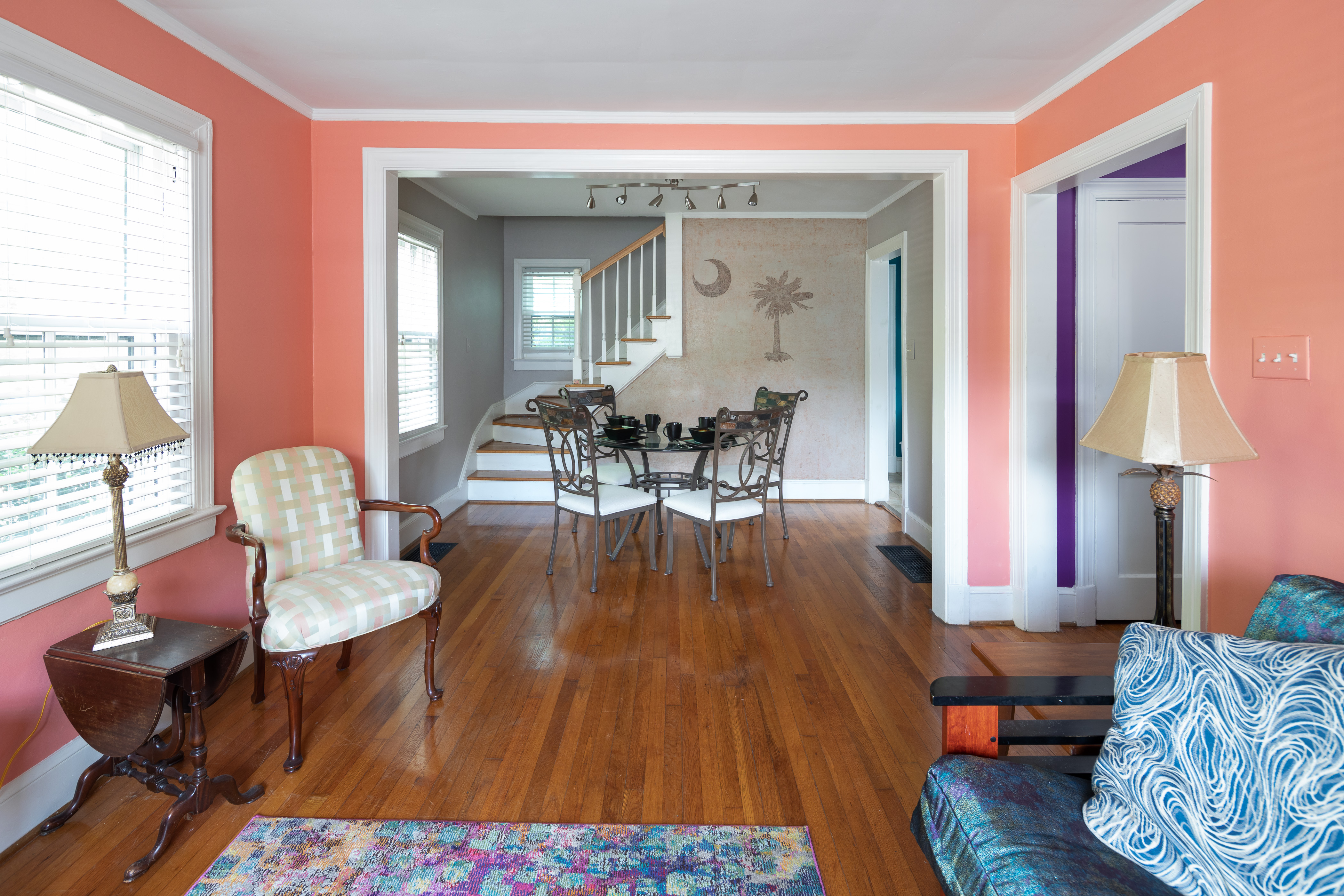 On the side I live in I went with a coral and an earthy gray, but added some interest with a Palmetto State symbol done in colored wax.
On the side I live in I went with a coral and an earthy gray, but added some interest with a Palmetto State symbol done in colored wax.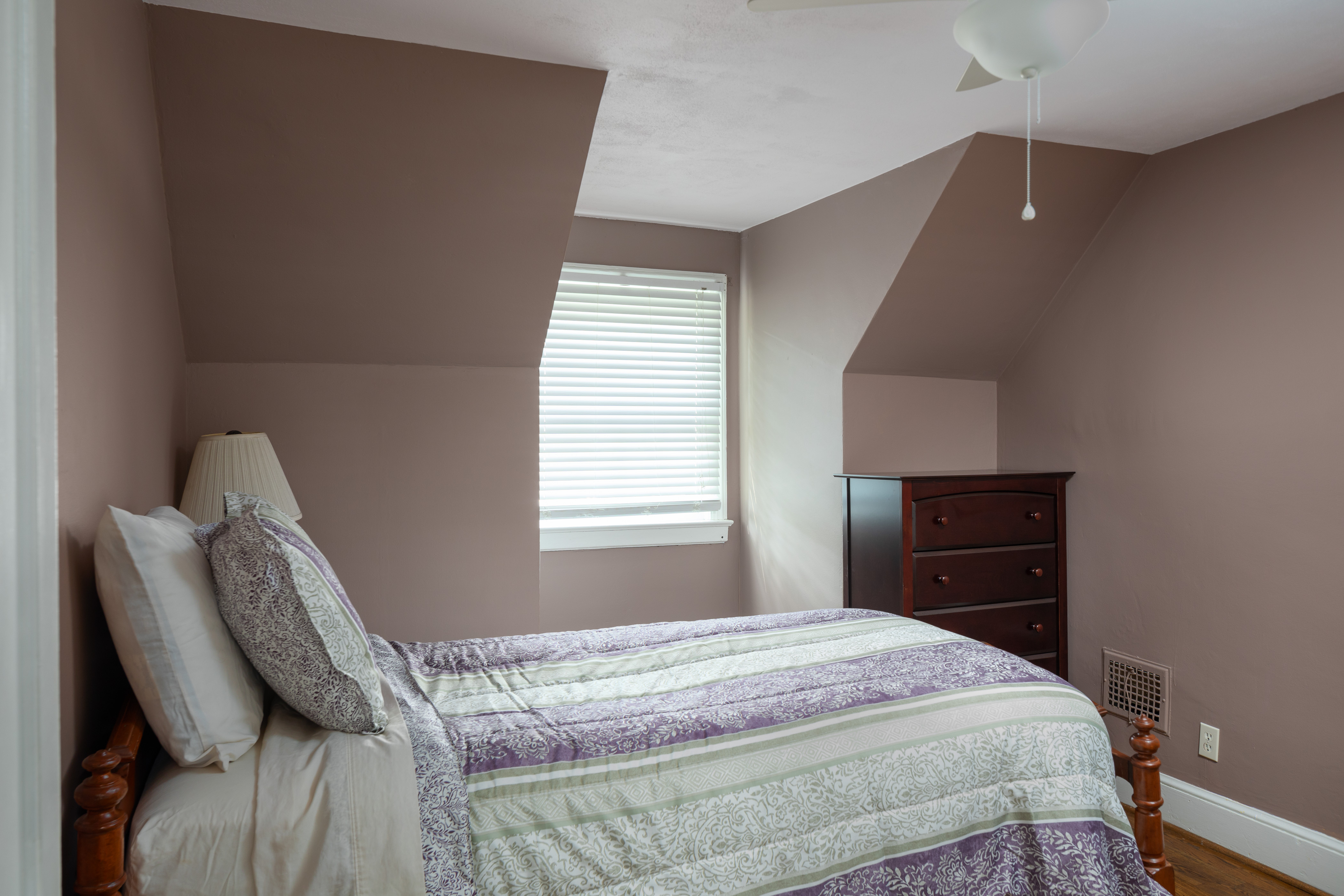 This is the mulberry gray I decided I did not like. Maybe I just need a colorful bedspread?
This is the mulberry gray I decided I did not like. Maybe I just need a colorful bedspread?The unit I chose to offer on Airbnb was the side with the new kitchen, but it lacked two things. There was no microwave and no kitchen vent. There was a hood with a fan, but it had no vent. Nothing.
This ended up being my single largest project. The range was on the interior wall. Perhaps I could have moved the range to the opposite wall, but this would have required redoing the cabinets. I opted to run a vent across the ceiling.
I combined this with the addition of a microwave. This is a microwave that has a built in range fan underneath it. I mounted it over the range and vented through a pipe that I ran over the top of the existing cabinets, then across the ceiling and out the exterior wall. There were no upper cabinets where the range stood, so I had to build these, then I had to build a drop down from the ceiling to hide the vent pipe.
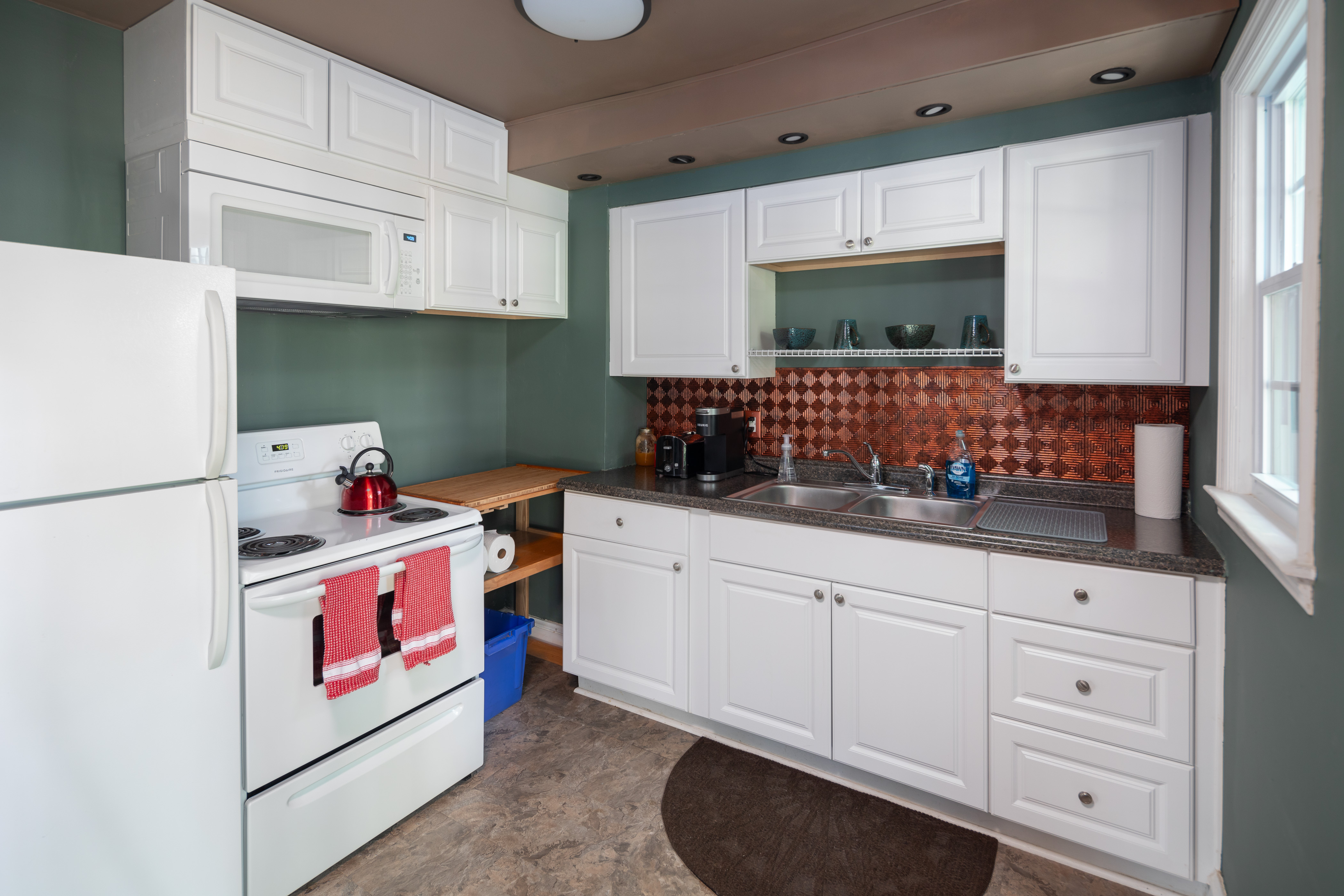 It is a small kitchen, but much bigger than what you get in a hotel suite. The copper backsplash adds some nice color and goes well with the muted green walls.
It is a small kitchen, but much bigger than what you get in a hotel suite. The copper backsplash adds some nice color and goes well with the muted green walls.It was this project that taught me how to use a biscuit joiner. There was a learning curve, but it is fairly easy to use, and the results looked fairly professional.
The problem I encountered was a large sag in my ceiling. It dropped 1 and 3/4 inches in the center. It turns out that many years ago they replumbed the upstairs bathroom. To do this they had to cut a supporting beam. This would have been acceptable but they didn't bother to replace it with anything. Over time the floor above sagged.
I use a house jack to raise the floor back up. These are fairly cheap. I think maybe $60. With one jack I raised it up one inch, but at that point the jack looked like it was starting to bow and I was afraid of doing some damage in the bathroom upstairs. I settled for my one inch improvement and reinforced where the cross beam had been cut.
Upstairs the sagging in the floor was evidenced by a bathtub that tilted to one side and a gap between the bathtub and the bath tiles. Jacking the floor up reduced the tilt, but I still had a gap. I think I know my limits, and any tile work I would have done here would have looked amateurish. I hired a pro to come in and add tiles to close the gap.
I also used a professional to replace one window damaged by water leaking from a bad gutter. I later replace the front upstairs windows, but those were optional. This window was necessary.
Remember how I said that the house needed new paint on the outside? The siding is wood shingles. They have to be repainted every few years and if it isn't done right it will be few indeed. I had several painters come quote, and found one I liked, but he was injured on another job before he started. That left me scrambling for a new painter well into fall. I found one, and he started as soon as he could, but winter came and it was wet and the job dragged out until May.
The house had been gray. It was a fine color, but did not stand out. I ended up going with a blue with a little bit of green in it. It is almost a teal, but not quite. I was going for teal and I think I would have liked that but when I painted samples on my house it never looked right. So I kept creeping closer to pure blue. What I ended up with turned out pretty good, as I have received several compliments on the color.
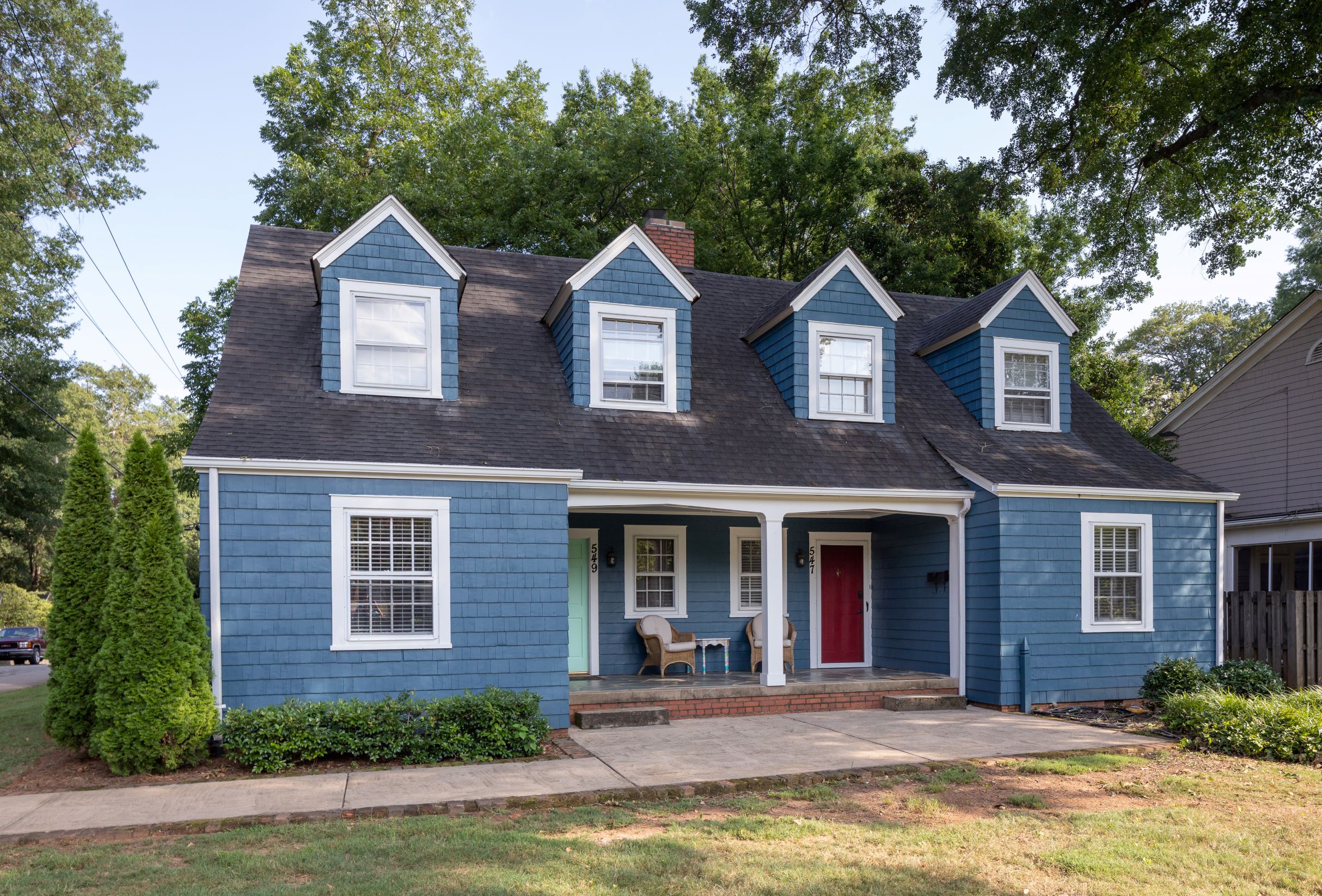 The green in this blue doesn't show up in this photo, but it becomes more apparent in the shade.
The green in this blue doesn't show up in this photo, but it becomes more apparent in the shade.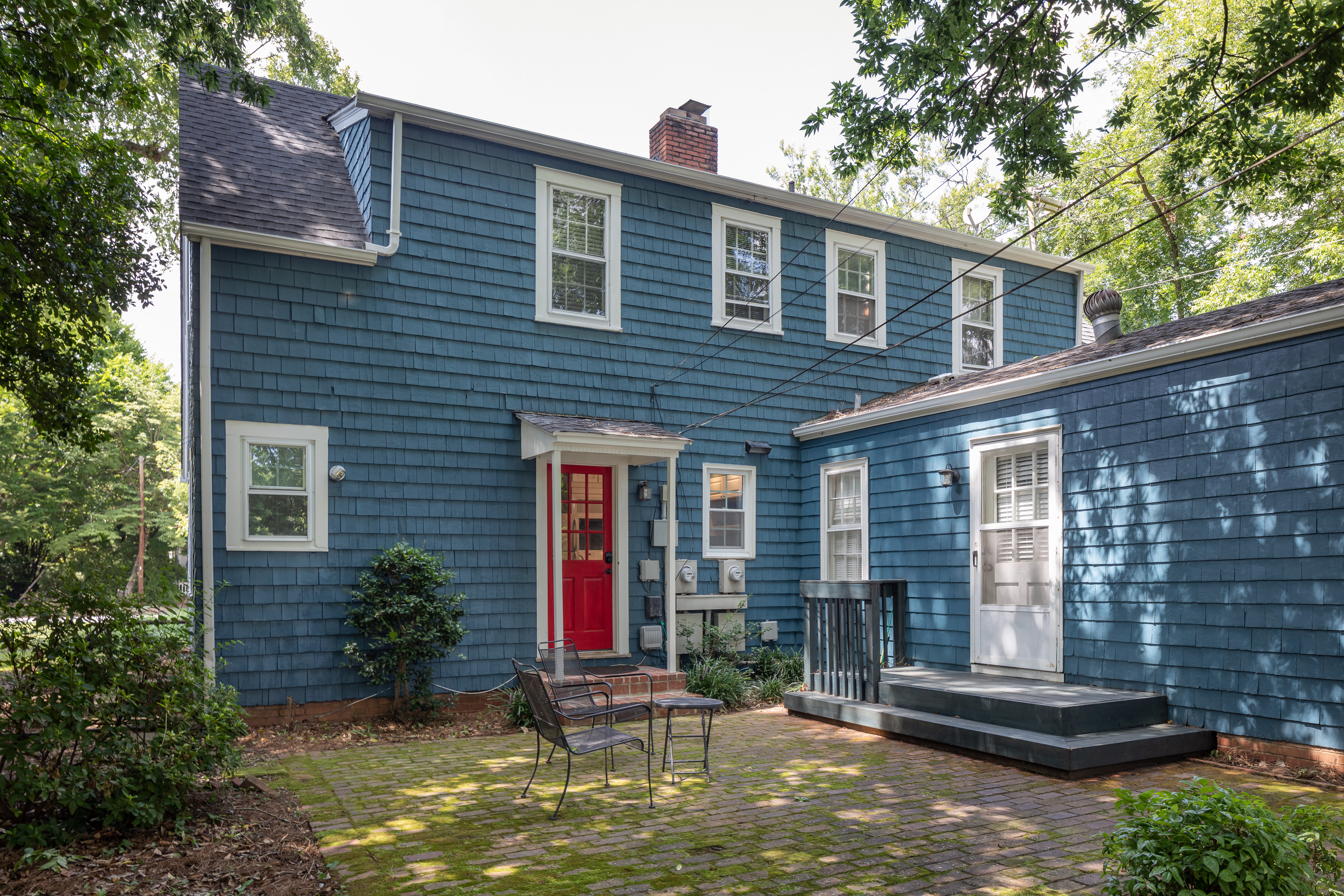 But, as I said, the green is just barely there.
But, as I said, the green is just barely there.It is more vibrant than most the house colors in Converse Heights. The colors tend to be more subdued. Maybe I had an effect on the neighborhood. Five months after painting my house a neighbor painted his house a purplish blue.
The painter sanded off the old paint. Unfortunately this sometime leaves a grinding pattern on the shingles. He then laid down a primer coat. i used Benjamin Moore Fresh Start oil primer, tinted to be close to the top coat color.
The top coat color is Behr Observatory. I used their Marquee line. My painter swore by Behr. His name is Lloyd Thibodeau and I recommend him. He likes to use a brush rather than a sprayer, and I think that is a good choice for wood shingles.
I replaced all the gutters. I considered doing this myself, but I wanted larger gutters than I could find at Home Depot and I wanted seemless gutters.
Insufficient capacity for my steep roof and bad seams were the cause of much damage. I used about ten boxes of shingles replacing water-rotted shingles. In one spot I used almost a whole sheet of wood to replace the rotted backing board.
I used HomeCraft Gutter Protection, which seemed to have a better product. I was home when they installed it. They did a great job and had it finished in one day.
My house has most of its original sash windows. As with many older homes, some are painted shut. They all have storm windows, which helps with the energy bills, but they are a pain to clean. I have always wanted to have really nice windows installed, but did not want wood windows, because of the maintenance concerns. For synthetic frames your best option is Andersen Windows.
All windows are pricey. Andersen are especially expensive, but they use a much stronger material which doesn't have the expansion and contraction problems inherent in other options like vinyl or aluminum. I ended up replacing the four second-story windows that face the street. Those are the hardest to clean, so having double-paned windows that tilt and clean were especially important.
I consider this one of my two luxury purchases. I could have lived without the new windows, but I think I will get my money back on these when it comes time to sell this house. Eventually I hope I can replace all the old windows.
My other luxury purchase was the use of Dekton Ultra Compact countertop in the second kitchen. With the help of fresh paint I was able to keep the old cabinets, but the counter and the sink had to go.
Dekton is an artificial granite-like material. It is ceramic and glass heat fuzed together. Compare this to Quartz. Quartz counters use some kind of glass, ceramic or stone, but then use a resin (plastic) to bind the particles together. With Dekton they are just melted together. There is no plastic. If you put a hot pan on it the counter won't scorch.
There is no need to seal the material. It is not porous. No annual coating. But it can be a budget buster. The only way I could afford it was that I had limited counter area to begin with.
It's advantage over granite is that it doesn't need to be sealed. That sealant leaves granite countertops sensitive to heat. The granite won't scorch but the sealant might.
I justified this purchase in my mind by saying I wouldn't have to worry about damage to the counter at some point in the future. It will save me money, right? Well, maybe. But honestly I bought it because I love how it looked and I loved its technical superiority.
For now this kitchen is mine. Later I may rent out this side as well, but for now I get to enjoy this kitchen and I am loving it.
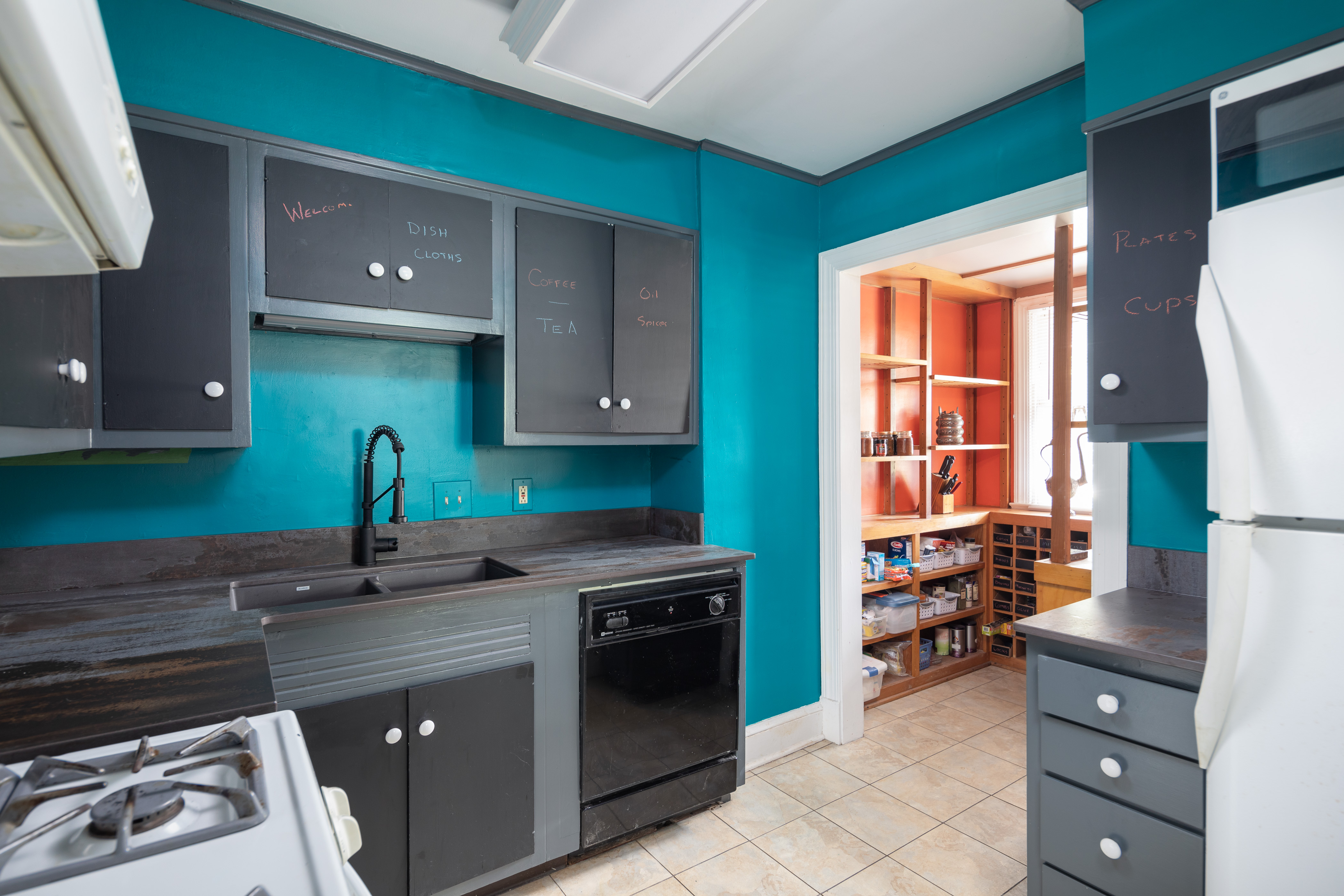 Teal walls, blackboard cabinet doors, and a blood orange pantry make for an exciting kitchen.
Teal walls, blackboard cabinet doors, and a blood orange pantry make for an exciting kitchen.My house has a really nice back patio. I love it, but the only lights for enjoying it at night were bright, garish porch lights. I added an external electrical outlet and strung up patio party lights.
On the less glamorous side, my duplex has two basements. The water table here is naturally high, and all the basements here flood. My first year was a record year for rainfall. I ended up pressure washing the basements. The one also serves as a laundry room, so that one now has a painted floor and painted walls. Actually the walls were painted, but they just used regular paint and it flaked terribly. I used a masonry paint from Sherwin Williams called Loxon XP. Like the name says it is supposed to lock onto the masonry and not flake. We will see.
To prevent flooding I added sump pumps. I knocked holes in the floor with an electric jack hammer, and used a paint bucket for the sump. So far I have had good luck. Most of the water gets pumped away, and my dehumidifiers can handle the rest. All the mold is gone, and I can spend time in the basement without putting my health at risk.
So, how is the Airbnb going? Up and down. It is making more money than a straight rental, and in my better months about twice as much, but more and more owners are entering this market, so new competition has made my most recent months marginally profitable compared to a long-term renter.
I think I can improve my marketing and get a higher occupancy rate, but that is still speculative. I have been tracking who the players are in my local market and I have noticed that several houses have disappeared from the listings. I don't know for sure, but I suspect that some people found that it wasn't worth the extra effort, and they reverted back to long-term rental units.
Airbnb's really compete against hotels, and you would think that the prices should be similar. In most cases an Airbnb will be quite a bit cheaper, at least for long stays, and you usually get a lot more. For me the big advantage is not having to stay in a hotel that is devoid of personality and looks just like the place you stayed in last night.
In my local market there are many hundreds of hotel rooms, but only maybe a few dozen airbnb rooms available. It shouldn't make a difference if one more airbnb unit comes online, but the number of people who even consider looking at an airbnb is still low. Over time that will change. People are getting used to the idea of using Uber and their comfort with the sharing economy is growing.
My own personal experience is as a business traveller, and so I have organized my airbnb to appeal to this market. I have electronic locks and I send my guests a code. They don't have to knock on my door and get a key. They can arrive at midnight if they want.
I also have a flexible cancellation policy. Like most hotels I will charge you for a night if you bail at the last minute, but only for the one night. The rest of the stay will be refunded.
Airbnb makes this easy for me. The host gets to set the cancellation policy. Most hosts do not offer that flexibility, but I know my biggest fear when booking is that my trip will be altered and I will be on the hook for the whole trip. So when I search for an airbnb I look at the cancellation policy.
One of the biggest obstacles for getting business travelers is the corporate travel department. Some book for the traveler, and they tap into the hotel listings. Some companies have strict policies that favor certain hotels or make it hard to make your own reservations. In these places you take some risk making your own arrangements.
With my old employer I had to buck the system. I would look at the hotel costs and then make my own arrangements, but it took a little courage and most people won't do that. This will change, but slowly.
With my current company I have flexibility, so long as my costs are lower than the hotel rates. However this is because I am a contractor. The permanent associates are locked into a travel agency that would never let them book an airbnb.
Addendum
Since I wrote this article a lot has changed. I lost my job and Covid hit. I found a job and moved away. At the beginning of 2020 I knew this would be a year of change, so I started renting out both sides of my duplex. I took extended "vacations" visiting friends and relatives, and generally sponging off someone else.
Yes, Covid hit pretty hard for a short while, but mostly I kept my place booked. If you want to hear about my year financially I discuss it in AirBnb Investing.
Please!




New! Comments
Have your say about what you just read! Leave me a comment in the box below.